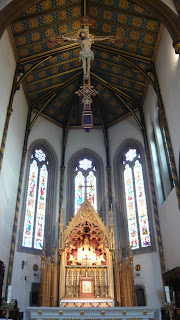Over the
last couple of days I've been following part of the Pugin Trail around Birmingham Birmingham , is available from Birmingham's tourist
information offices, museums and libraries as well as other key venues
including St Chad
The Cathedral and Bishop’s House (originally opposite), and their interiors, were designed by Pugin. The cathedral is an internationally significant building, being the first Catholic cathedral to be built in the UK since the Reformation. The cathedral was built by George Myers (‘Pugin’s Builder’) and the original internal decorations and fittings were made by craftsmen who re-introduced medieval techniques of production: William Warrington, the chancel windows, 1841; John Hardman junior, the plate and, after 1845, several splendid windows; Herbert Minton, the floor tiles. Pugin’s magnificent rood screen was removed in a re-ordering, in 1967. The vestments were made by Lucy Powell and colleagues, to Pugin’s designs, many surviving to this day. Pugin, a collector of antiquities, also provided the Cathedral with some fine original medieval furnishings, acquired on his continental journeys, including the 15th century German Canons’ stalls and the pulpit. Beneath the Cathedral is a spacious Romanesque-style crypt containing several chantry chapels.
A delightful print display and trail ‘Pugin, Dürer and The Gothic’ runs at the BarberInstitute of Fine Arts until 24 June. Exhibits are from the Barber’s own collection and include a late medieval Brussels wood carving of Joachim and Anna, once owned by John Bernard Hardman; an early Netherlandish triptych of the Deposition, once owned by Pugin; a collection of eight prints and one drawing by Dürer, widely recognised as the greatest German Renaissance artist and a prime inspiration to Pugin, and a Pugin octagonal table on loan from King Edward’s School.
In 1838, Pugin persuaded his friend,
John Hardman (1811-1867), to turn his Birmingham
Winterbourne House,
also on the Pugin Trail is a rare surviving example of an early 20th century
suburban villa and garden. The house was built in 1903 for John and Margaret
Nettlefold, of Guest, Keen & Nettlefold. Designed as a small country estate
the house boasted rustic outbuildings and large gardens. Both the house
and garden follow the style of the Arts and Crafts movement with examples of
local craftsmanship throughout.
I also visited the Ikon Gallery and was intrigued by Postcards From Japan - A Message From Tohoku Artists, a touring
exhibition of A5 works by 22 artists from North East Japan marking the
first anniversary of the devastating earthquake and tsunami that hit north
east Japan
--------------------------------------------------------------------------------------------














No comments:
Post a Comment